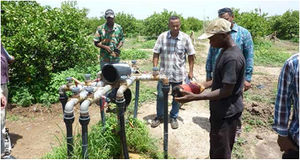SPIS Toolbox - Irrigation Head

| ►Back to the Start Page | ►Back to the Module Page | ►Go to the Next Chapter |
8. Irrigation Head
The irrigation head is the part of the irrigation system where the water quantity, quality and pressure are managed. It is indispensable in irrigation systems that operate under pressure such as sprinkler and drip irrigation.
The irrigation head typically contains:
- valves to control the quantity of water flowing to the different sections of an irrigation system;
- filters to remove particles that could block drip emitters or sprinkler nozzles;
- a fertigation system to mix soluble fertilizer in the irrigation water;
- pressure regulators.
In surface irrigation systems, the irrigation head may contain valves only. The irrigation head of drip and sprinkler systems contains at least a valve and a filter.
Valves
The irrigation system is usually divided into several sections to improve the control of the quantity and pressure of water in the field. The water flowing in each section is controlled by manual or automatic valves. Automatic valves can be volume- or time-controlled. The producer determines the required irrigation volume per section, and the automatic valve closes as soon as the target value is reached. It is recommended to use volumetric valves especially in cases where water is directly pumped to the irrigation system without passing through a reservoir. The disadvantages of automatic valves include high costs and regular replacement, and they inhibit pressure loss through the device.
Filter
A filter is essential in any sprinkler or drip irrigation system as it reduces the occurrence of clogging of nozzles and emitters. Clogging is caused by inorganic material such as sand and clay, as well as organic material such as algae and bacteria, that accumulate and block the emitter. Depending on the quality of irrigation water (i.e. sediment, dissolved salts, etc.) filters must be cleaned multiple times per day.
Initially, a water analysis can provide information on the size and amount of particles, and from this you can identify the correct filter technology required. However, this may not be a feasible solution for all farm sites as some may not have access to test kits or laboratories. Surface water from a reservoir or river needs to be filtered much more frequently than water from a well or borehole, where the water is filtered naturally in the ground.
When choosing a filter for an SPIS it is important to realize that:
- filters must be adapted to the flow rate of the pump;
- the pressure loss through the filter should be minimized and monitored;
- maintenance should be easy and the lifetime should be long.
There are three major filter systems:
- screen filter: a filter using a stainless steel (mesh), polypropylene, nylon or polyester screen to separate particles from the water. The pressure loss in screen filters tends to be quite high; therefore they are not recommended for use in SPIS.
- disc filter: a disc filter element contains a stack of compressed discs with an overlapping series of grooves. Unfiltered water passes through the stack of tightly compressed discs and the water is forced to flow through the interlocking grooves of the disc rings where debris is trapped. Dirt particles are caught on a very large surface, which is the reason for the comparatively low pressure loss. For manual cleaning, the filter rings have to be taken out of the enclosure and rinsed with clean water. When using disc filters for SPIS, it is advisable to install the next larger model to reduce the characteristic pressure drop, which is proportional to the flow rate, or to install two filters working in parallel. The maintenance intervals should be short so as to significantly reduce the accumulated pressure loss. Automatic backflush systems work with considerably higher pressure and therefore do not suit the pressure minimizing concept of SPIS.
- Granulate/sand filter: these filters have a large capacity to remove particulates from water. Water is routed through a sand-filled metal tank where the sand traps large and small particles. Eventually the dirt accumulates in the space between the sand particles, requiring a backflushing with clean water. The sand filter requires high pressures for operating and backflushing, which makes it less suitable for SPIS.
| ►Back to the Start Page | ►Back to the Module Page | ►Go to the Next Chapter |




















